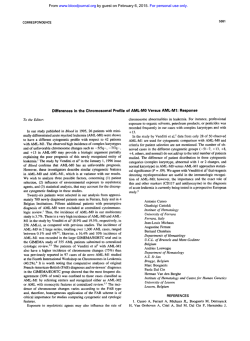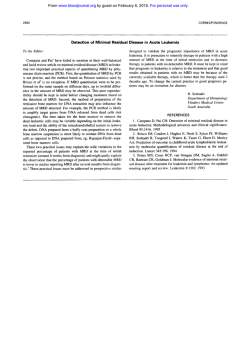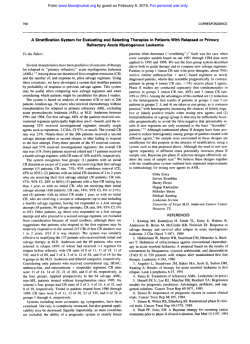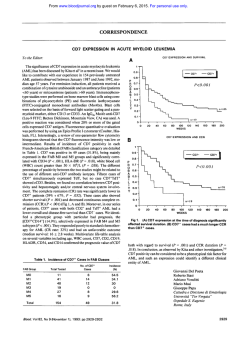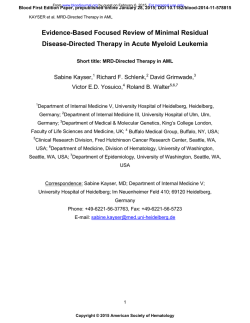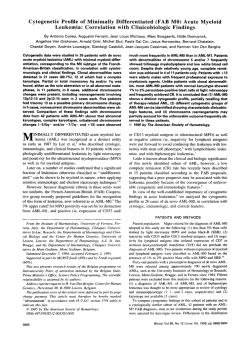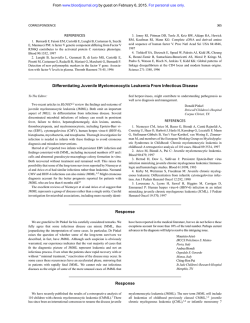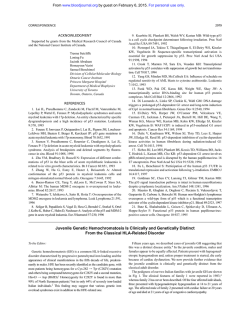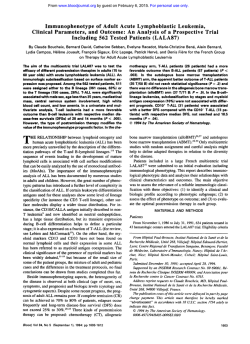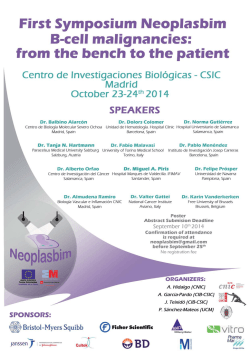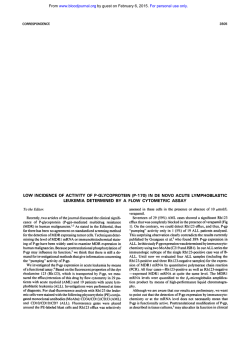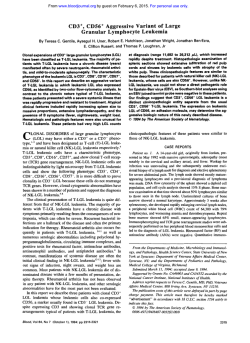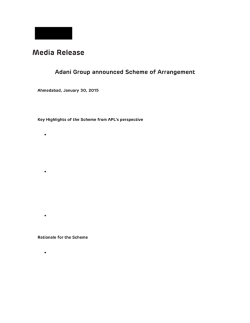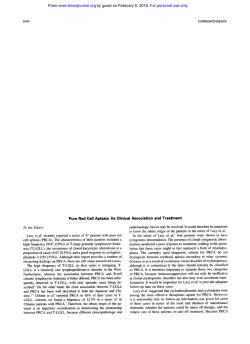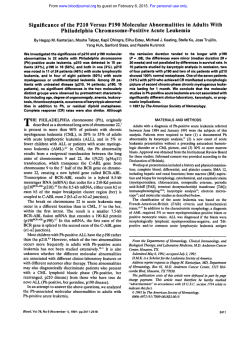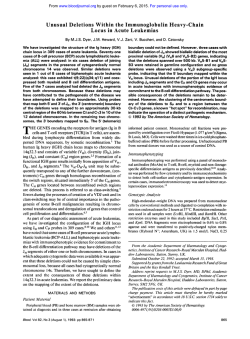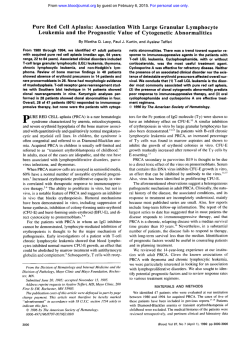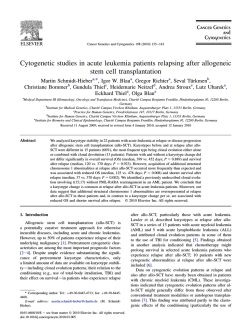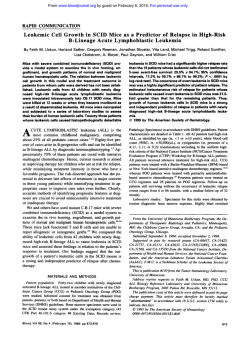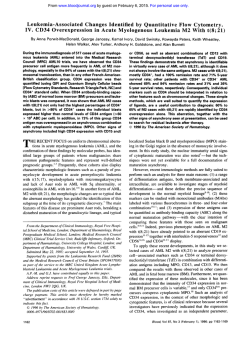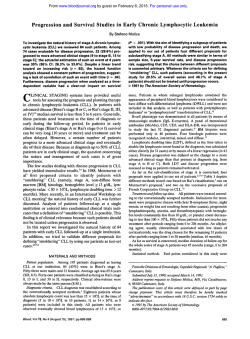
About the Increased Frequency of Acute Promyelocytic
From www.bloodjournal.org by guest on February 6, 2015. For personal use only.
2357
CORRESPONDENCE
About the Increased Frequency of Acute Promyelocytic Leukemia Among Latinos:
The Experience From a Center in Spain
To the Editor:
Recently, Douer et all found that Latinos with acute myeloid
leukemia (AML) have a higher likelihood of the acute promyelocytic
leukemia (APL) subtype of disease, whichmay suggest either a
genetic predisposition to APL and/or exposure to distinct environmental factor($. The Latino ethnic group was defined in their report
based on the origin of the patient: Central and South America, although we assumed that patients from Mexico (North America) were
also included in the Latino group. This definition is, in our opinion,
based more on cultural features than on racial or even ethnic reasons,
because an important mixture of races occurred after the Spanish
colonization of America that involved people from the Iberian peninsula, the authoctonous American natives, and, in some areas, black
people from Africa. Thus, what was described as the Latino group
is an heterogeneous group of races. Nevertheless, we have also found
a high incidence of APL in our center in Madrid (Spain) when
compared with other regions in North Europe’ or white people from
the United States.’ FromJanuary 1986 to December 1994, 104 Spanish patients who were mainly from the region of Madrid were diagnosed as having de novo acute myeloblastic leukemia in our center.
Their median age was 47 years (range, 13 to 82 years), and 24 cases
corresponded to APL (23%). The rest of the cases were MO (l),M1
(14), M2 (22), M4 (1 l), M5 (25), M6 ( 9 , and M7 (2). Patients with
APL were significantly younger, with a median age of 29 years
(range, 16 to 59 years) versus 49 years (range, 13 to 82) for those
without APL ( P < ,001 t-test). This finding and the increased fre-
quency of APL in the Italian population4could favor the hypothesis
of a racial predisponition for APL, although other environmental
factors cannot be completely excluded.
J.F. Tomis
J.M. Fernindez-Ratiada
Hospital Universitario La Princesa
Universidad Autdnoma de Madrid
Madrid, Spain
REFERENCES
1. Douer D, Preston-Martin S , Chang E, Nichols PW, Watkins
KJ, Levine AM: High frequency of acute promyelocytic leukemia
among Latinos with acute myeloid leukemia. Blood 87:308, 1996
2. Cantti-Rajnoldi A, Biondi A, Jankovic M, Masera G , Rovelli
A, Uderzo C, Head D, Raimondi S , Creutzig U, Ritter J: Diagnosis
and incidence of acute promyelocytic leukemia (FAB M3 and M3
variant) in chilhood. Blood 81:2209, 1993
3. Steuber CP, Civin C, Krischer J, Culbert S , Ragab A, Ruymann
FB, Ravindranath Y, Leventhal B, Wikinson R, Viett TJ: A comparison of induction and manteinance therapy for acute non-lymphocytic leukemia in childhood: Results of a pediatric oncology group
study. J Clin Oncol 9:247, 1991
4. Biondi A, Rovelli A, Cantu-Rajnoldi A, Fenu S , Basso G ,
Lucian0 A, Rondelli R, Mandelli F, Masera G , Testi AM: Acute
promyelocytic leukemia in children: Experience of theItalian Pediatric Hematology and Oncology Group (AIEOP). Leukemia 8:1264,
1994
From www.bloodjournal.org by guest on February 6, 2015. For personal use only.
2358
CORRESPONDENCE
Response
AsDrs Thomas and Fernandez-Raiiada correctly comment, we
defined Latinos as people originating in Central and South America
and Mexico. We agree that the genetic background of these populationsisindeed heterogenous and includes ancestors from Europe,
different American Indian tribes, and other races. The patient populations that we studied were notlarge enough to examine more homogenous Latino subgroups for the frequency of APL. Whether the high
frequency of APL seen in Los Angeles County relates to place of
residence before diagnosis of APL, to dietary or life style habits, or
to a specific genetic background isasyet undetermined. Weare
currently beginning an international study involving patient populations from the United States, Mexico, and Argentina in an attempt
to address the specific issue of Latino subpopulations.
As referred to in our report, a higher than expected frequency of
APL has also been noted in a series of AML patients from different
countries in Central and South America"' and Italy'.' and the
information provided in the letter of Drs Thomas and Femindez-RaRada
extends this observation to AML patients in Spain. However, it is
important to recognize several potential biases in studying the frequency of APL among AML patients. Thus, data from hospitals
could be biased by distinct referral patterns. For example, APL is a
disease of younger adults, whereas other AML subtypes are more
common in older patients. Referral of elderly patients with AML to
a hospital for intensive treatment could be lowerbecause of an
expected poor outcome. This could favor a higher rate ofhospitalization of APL cases than other AML patients and could artificially
increase the proportion of APL. In addition, careful pathologic verification of non-APL cases is extremely important. The morphologic
criteria for APL are themost specific, sensitive, and reliable of
all French-American-British (FAB) subtypes.(' Howevernon-APL
cases, in particular FAB subtypes MO and M I , if erroneously misclassified, are more likely to be defined as
acute lymphoblastic leukemia rather than APL. In that case. the number of non-APL cases
and the total number of AML cases would decrease, resulting in a
spurious increase in the proportion of APL among AML cases. Our
study tried tominimize these biases by comparing Latinos with nonLatinos, by adjusting the risk of APL for age, and by using population-based data with central pathologic subgroup verification of all
AML cases. We believe that our conclusion that APL is more frequent in Latinos with AML is valid. The observation of Drs Thomas
and FernLndez-Raiiada and other similar reports point to the same
conclusion, ie, that APL may have an uneven geographic or ethnic
distribution and that APL may be more
frequent inAML patients
in certain population groups that are categorized as Latinos. Further
research on the epidemiology of AML must be subgroup-specific.
Dan Douer
Alexandra M. Levine
Division of Hematology
Department of Medicine
Susan Preston-Martin
Department of Preventive Medicine
Peter W. Nichols
Department of Pathology
The Norris Comprehensive Cancer Center
University of Southern California
Los Angeles, CA
REFERENCES
1. Malta-Corea M, Pacheco-Espinoza C, Cad-Rajnoldi A,
Conter V, Lietti G, Masera G, Sessa C, Cavalli F, Biondi A, Rovelli
A: Childhood acute promyelocytic leukemia in Nicaragua. Ann Oncol 42392, 1993
2. Loureiro P, Azevedo A, Maia A, Freire AD, Souto F, Bandeira
F, Vasconcelos J, Paiva A: Acute myeloid leukemia: Presentation
of the disease and response to treatment in Northeast of Brazil. Med
Pediatr Oncol 20:439, 1992 (abstr)
3. De Salvo L, Weir-Medina J, Gomez-Sanchez 0, de Baena ES,
de Ramos BU, Guevara J, Leungo Vera J, de Vizcaino MA, Sanchez
H, de Leon E: Leucemia promielocitica aguda en el occidente de
Venezuela. Sangre 34:329, 1989
4. Canth-Rajnoldi A, Biondi A, Jankovic M, Masera G, Rovelli
A, Uderzo C, Head D, Raimondi S, Creutzig U, Ritter J: Diagnosis
and incidence of acute promyelocytic leukemia (FAB M3 and M3
Variant) in childhood. Blood 81:2209, 1993
5. Biondi A, Rovelli A, Cantu-Rajnoldi A, Fenu S, Basso G,
Luciano A, Rondelli R, Mandelli F, Masera G , Testi AM: Acute
promyelocytic leukemia in children: Experience of the Italian Pediatric Hematology and Oncology Group (AIEOP). Leukemia 8:1264,
1994
6. Bennett JM, Catovsky D, Daniel MT, Flandrin G, Galton AG,
Gralnick HR, Sultan C: Proposed revised criteria for the classification of acute myeloid leukemia. Ann Intern Med 103:626, 1985
From www.bloodjournal.org by guest on February 6, 2015. For personal use only.
1996 88: 2357-2358
About the increased frequency of acute promyelocytic leukemia
among Latinos: the experience from a center in Spain [letter;
comment]
JF Tomas and JM Fernandez-Ranada
Updated information and services can be found at:
http://www.bloodjournal.org/content/88/6/2357.citation.full.html
Articles on similar topics can be found in the following Blood collections
Information about reproducing this article in parts or in its entirety may be found online at:
http://www.bloodjournal.org/site/misc/rights.xhtml#repub_requests
Information about ordering reprints may be found online at:
http://www.bloodjournal.org/site/misc/rights.xhtml#reprints
Information about subscriptions and ASH membership may be found online at:
http://www.bloodjournal.org/site/subscriptions/index.xhtml
Blood (print ISSN 0006-4971, online ISSN 1528-0020), is published weekly by the American
Society of Hematology, 2021 L St, NW, Suite 900, Washington DC 20036.
Copyright 2011 by The American Society of Hematology; all rights reserved.
© Copyright 2025
